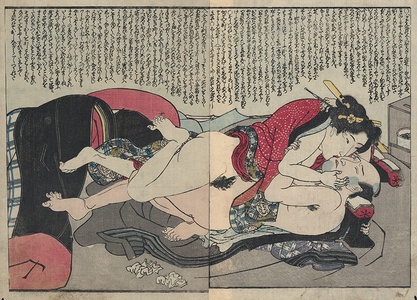| Method | Woodblock (nishiki-e) |
| Artist | Utagawa Kunisada (Toyokuni III) (1786-1865) |
| Published | 1825 |
| Dimensions | Two Hanshibon sheets [each sheet ~222 x 155 mm] |
| Notes |
Series: Hyakki yagyō: Night Parade of One Hundred Demons Author: Utei Enba II A print from Volume III of Hyakki yagyō: Night Parade of One Hundred Demons, Kunisada's first erotic book. A geisha and client lie on the floor entangled and kissing, his head on a takamakura (raised sleeping pillow), a kimono draped on her shoulders. The title of this series is a reference to the Japanese folk tale of the procession the supernatural creatures of the oni and yōkai. through the streets of Japan at night. In this series Enba and Kunisada liken the oni and yōkai literally genitalia but also the allures of sex, commercial, sex, and sex workers. Shunga is the term used for the body of erotic imagery produced in Japan from 1600 to 1900. The term shunga means spring pictures, a euphemism for sex, and is one of several names for erotic material produced in Japan. Shunga took different formats: painted hand scrolls, painted books, printed books and albums, and sets of prints which were sometimes sold in wrappers. As prints they are one of the genres of ukiyo-e, or Floating World prints, which also include fukeiga (landscape prints), and bijin-ga (prints of beautiful women). Most of the major ukiyo-e artists produced shunga material at some point during their careers, including Utamaro (who produced more erotic books than non-erotic books), Hokusai, and Hiroshige. Produced at the same time as the introduction of full colour woodblock printing, shunga prints and books were made using the most lavish and complicated printing techniques, including gauffrage, metallic inks, mica, complicated printed patterns, and multicolour printing using a high number of different colours. Although prolific in its number and variety, shunga should be seen as more representative of the ideals of the ukiyo, with its emphasis on mutual pleasure, rather than as an accurate representation of Japanese attitudes and practices of sexuality. Shunga present an invitation to pleasure through the bliss of lovemaking and though largely heteronormative, they portray the full gamut of couplings, married or otherwise, often surrounded by lavish settings and objects of pleasure. Utagawa Kunisada (Toyokuni III) (1786-1865) was the most popular, prolific and financially successful designer of ukiyo-e woodblock print in 19th century Japan producing over 20,000 print designs as well as illustrated books. In his own time, his reputation far exceeded that of his contemporaries, Hokusai, Hiroshige and Kuniyoshi. The artist started his career as a pupil of Toyokuni I whose name he adopted in 1844 as Toyokuni III. Almost from the first day of his activity to until his death in 1865, Kunisada was a trend setter in the art of the Japanese woodblock print. Always at the vanguard of his time, and in tune with the tastes of the public, he continuously developed his style, which was sometimes radically changed, and did not adhere to stylistic constraints set by any of his contemporaries. He was not only a brilliant print maker but also an excellent business man who had great commercial success. Following the traditional pattern of the Utagawa School, Kunisada's main occupation was kabuki and actor prints, and about sixty percent all of his designs fall in this category. Notable students of his include Toyohara Kunichika, Utagawa Sadahide and Utagawa Kunisada II. From, the 1820s Kunisada produced approximately fifty erotic works. Many of his works were conceived and designed with author and poet Utei Enba II (1792-1862). Kunisada made several erotic parodies of popular novels including erotic versions of The Tales of Genji. Kunisada's shunga output is notable for the great attention to the settings of the shunga scenes including elaborate fabric patterns, porcelain, smoking sets, and the use of the most elaborate printing methods available at the time including embellishment with gold and silver pigments, mother of pearl, mica, lacquer printing, and gauffrage. Utei Enba II (1792-1869) was an Edo author of popular fiction. He also wrote a number of successful erotic books which he produced in collaboration with members of the Utagawa School including Toyokuni I and Kunisada. The works he collaborated on contain numerous novel devices to entice and entertain readers such as the inclusions of ghost, scandals involving kabuki actors, and trick pictures. His pen name was Enkobo Tsukinari. Ex. Col. Peter Darach Reference: The Gerhard Pulverer Collection, Freer Gallery of Art, Smithsonian, Washington D.C, FSC-GR-780.19.1-3. British museum. Suzuki Kenko. "popular cults if Sex Organs in Japan: Guardian Dieties, Auspicious Objects abd Votive Paintings." Condition: Very Good. Some rubbing and light soiling lower left and right corners. |
| Framing | unmounted |
| Price | £300.00 |
| Stock ID | 53187 |

